What is the Readiness Index?
The Readiness Index is a global behavioural science-led study delivering data and insights on how people feel about their future at work, and the factors that influence readiness. This study was commissioned by LHH, the world’s leading talent advisory and solutions company and its purpose is to calculate how ready workers worldwide feel about taking a new step in their careers. This is the first iteration of a three-year study where we focused primarily in the financial sector. With the collaboration of our research partners Cloud Army, we collected data from 2,000 people in three countries: France, US, and UK.
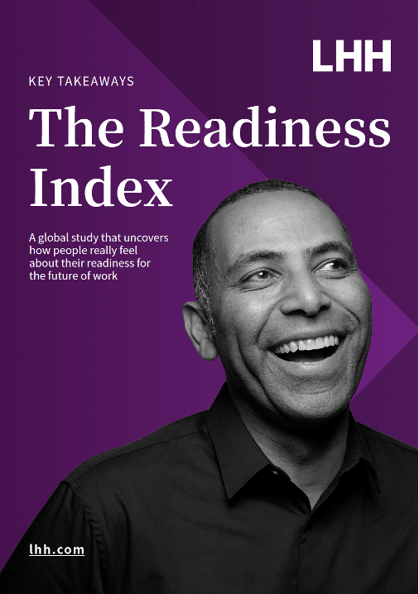
Why is the Readiness Index important?
The world is going through a period of transformation that has directly impacted the way we work. Most people are now coping with higher levels of uncertainty due to the COVID-19 pandemic or recent technological advances. How individuals and organisations handle job transitions, promotions and taking on leadership roles, will have a significant impact on their future success and wellbeing. This project will play a key role in uncovering what drives readiness.
How did we measure Readiness?
The index itself is built on an extensive psychological literature review exploring the themes related to taking the next step in one’s career. Armed with these findings, the index statistically quantifies which factors are most important in driving ‘readiness’. We focused on personal factors (e.g., anxiety, feeling in control, feeling excluded), workplace factors (e.g., poor management, concerns over company culture), and wider environmental factors (e.g., the impact of tech and the COVID-19 pandemic).
In terms of measurement, we went above and beyond traditional survey methods. From Behavioural Science, we know our behaviour is a result of two systems of thinking. One system works automatically, without our awareness, while the other one oversees our conscious thoughts and judgements. In this sense, the “conscious” part of our brains could lead us say that we are ready to take the next step in our career or face a new challenge. However, at the same time there might be deep “unconscious” emotions and thoughts that lead us to feel the opposite, ultimately preventing us from acting. Our index used mixed research methods to capture both conscious and unconscious responses.

What did we find?
The Global Readiness Score
Overall, the Global Readiness Score show a positive trend, with people feeling 7.7/10 ready to take the next step in their career.
We found differences by country, where people in the US are more ready to face new challenges compared to the UK and France.
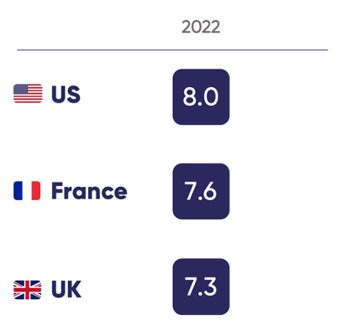
Data also suggests differences by age, where people between 35-44 years old are the readiest, whereas people between 18-24 are the least ready.
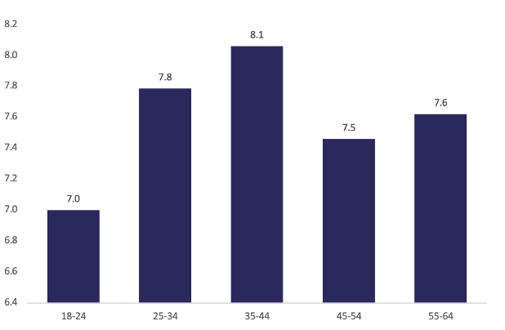
Interestingly, we did not find differences by gender in terms of general Readiness levels. Which suggests that overall, men and women are equally ready to face new challenges.
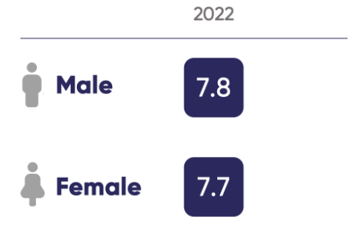
Which factors drive Readiness?
Main personal factors
1. On the personal level, the desire for change has the most relevance driving Readiness. The pandemic has shifted people’s priorities. People have been rethinking & re-evaluating their careers and those that are most ready are wanting a new start.
2. Furthermore, people who have made commitments in the form of career goals, whether it’s internalised or formalised, acts as a strong behavioural driver to feeling ready.
3. Finally, perceiving they have the skills to progress is key. People who have acquired the most skills or think they have a superior skillset are significantly more ready for their next career opportunity.
Main workplace factors
1. In the workplace financial motivation is the biggest driver of people getting ready for their next opportunity.
2. This combined with a culture that promotes people and makes them feel that they have a promising pathway drives readiness.
3. Workload levels could have a big influence on how people are feeling. They could either feel they are ready for a reward for all their hard work or that they’re overworked and need a change of direction.
Environmental factors
From a wider societal and environmental point of view, the key influences on people’s levels of readiness include, unsurprisingly, worries about their opportunity to have a flexible working mode, a lack of job opportunities and general health and safety (COVID – 19) concerns.
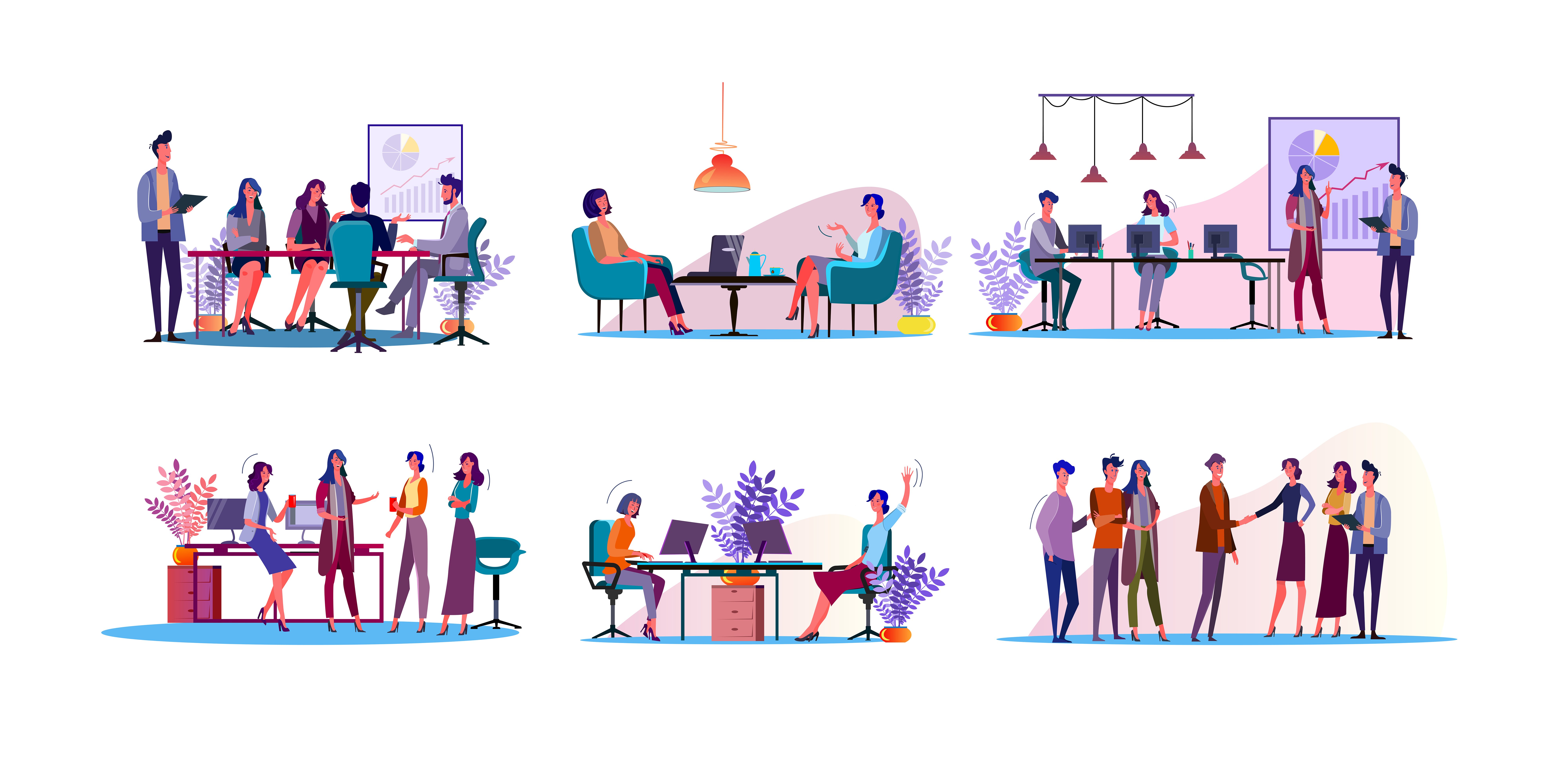
Three main trends
Emerging from this study are three patterns associated with Readiness. Aligned to these themes are a number of surprising findings that give us a unique understanding of people’s emotional attitudes towards work and their future careers.
The vulnerable youth
Aged 18-24 this cohort has the lowest Readiness Score. This group seems to be the most disillusioned as a result of starting their career in a post-COVID hybrid working world. They have the highest levels of anxiety and a lack of self-confidence which is related to a low level of control over their next step and a pessimistic outlook over their future.
As a result of remote working, they lack the opportunity for universal mentorship and therefore they are feeling excluded, they don’t get along with their colleagues and also feel as though their voice isn’t being heard.
- “55% of people between 18-24 years old are anxious about their next step”
- “This group tend not to have good relationships at work 34% feel they don’t get along with colleagues.”
- “18-24 year olds worry the most about all the environmental factors compared to older people.”
The gender gap
Although there is no difference between overall Readiness for males and females, we found some differences between the way they feel about themselves and about their workplace.
Women tend to have more harmonious relationships at work and don’t hold on to negative feelings about their colleagues and manager. As a result, they focus more on personal growth opportunities.
Men, on the other hand, tend to be more outward facing. They have a more negative perception of their manager and colleagues and tend to compare their salary more. For them, taking the next step is a competitive pursuit.
- “84% of women believe they have the necessary skills at work.”
- “Women are 16% more anxious about their next move than men.”
- ”Men are 48% more likely to say their manager is poor compared to women.”
- “Women are more worried about opportunities in hybrid working and lack of job opportunities.”

The rise of tech
Overall concerns about the rise of tech are moderate. People on average are slightly more concerned about more immediate environmental factors such as the economy and hybrid working. Perhaps this is unsurprising given our human inclination to focus on the present and discount the future.
Men are more worried about tech than women. By country, the French are more worried than the Brits and the Americans.
We can take a deeper dive into the group who are most worried about tech, ‘The Technophobes’. This group is more anxious and less optimistic. They feel like they can’t use their skills in the rapidly changing environment.
- “Men are 12% more likely to feel worried about the rise of tech than women.”
- “They feel like they can’t use their skills 20% more than average.”
- “They don’t get along with their colleagues 29% more than average.”

How is the Readiness Index being used?
The Readiness Index is changing the way LHH is doing business. The findings are being used to develop more empathetic and human services by understanding people’s true feelings and needs. Historically, recruiting services have been created to respond to how people say they are feeling using traditional research methods. Now, for the first time in the Talent Solutions Industry, a scientific measure has been developed to uncover how people say they feel about their work versus how they feel at an unconscious level. The findings are supporting the design of more effective solutions to solve the new challenges people face in their work lives.
What’s next?
The next phase is to expand the study to include more countries, including a wider variety of sectors. In total 10,000 people each year will be involved in the study until 2025 and we will be able to provide comparative reports highlighting the differences between the Readiness Scores worldwide annually.